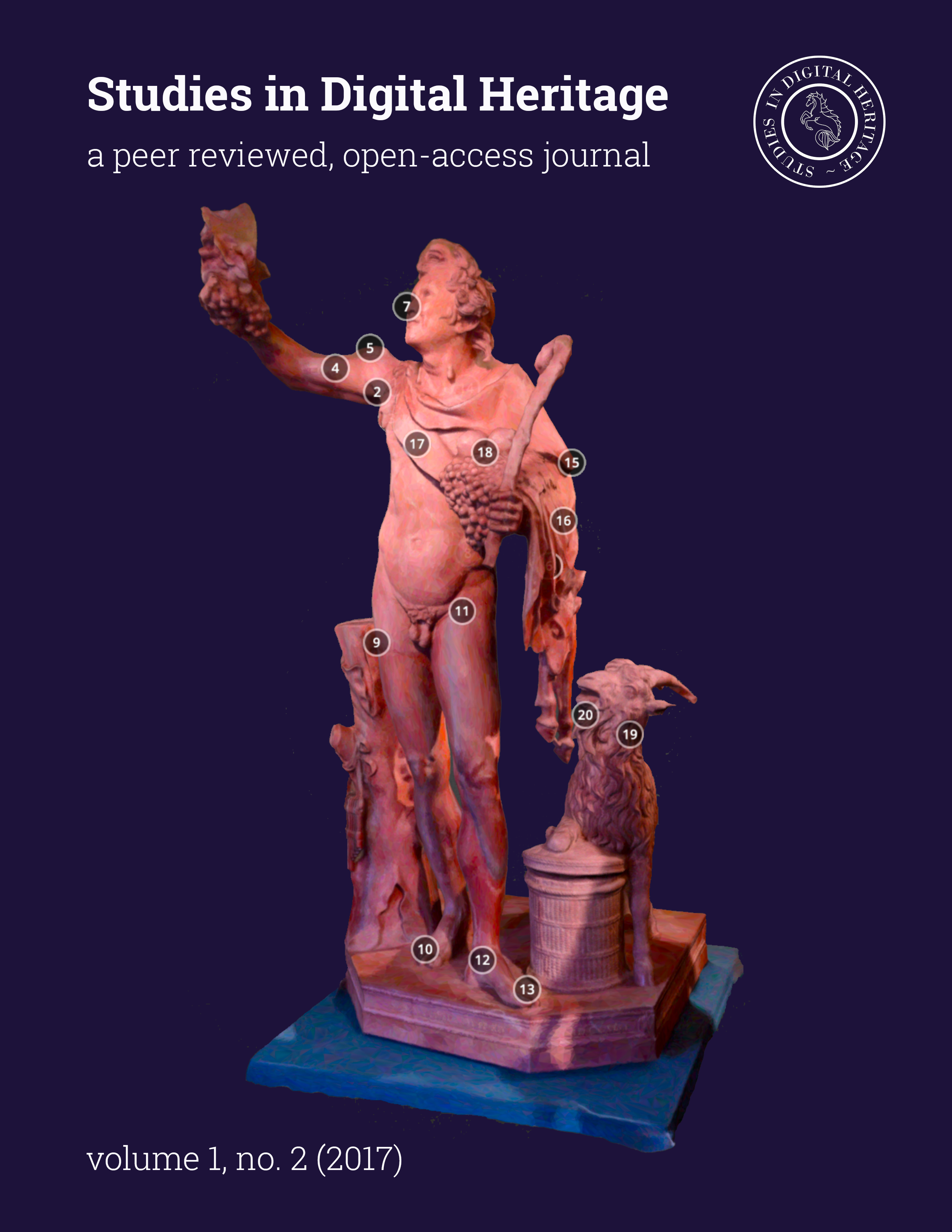Reconstructing Pre-Industrial Long Distance Roads in a Hilly Region in Germany, Based on Historical and Archaeological Data
Main Article Content
Abstract
Downloads
Article Details
From 18 May 2018, the contents of Studies in Digital Heritage are licensed under a Creative Commons Attribution-NonCommercial 4.0 International License (CC BY-NC 4.0). Our submitting authors pay no fee and retain the copyright to their own work.
How this works: to submit their work to the journal, authors grant Studies in Digital Heritage a nonexclusive license to distribute the work according to a CC BY-NC 4.0 license. Once an article is published, anyone is free to share and adapt its contents—provided only that they do so for noncommercial purposes and properly attribute the shared or adapted information. Details of these terms can be found on the Creative Commons website.
Download SDH’s full author agreement here
Studies in Digital Heritage will insert the following note at the end of any work published in the journal:
© [Year] by the authors. This article is an open-access article distributed under the terms and conditions of the Creative Commons Attribution License CC BY-NC 4.0 (https://creativecommons.org/licenses/by-nc/4.0/).
References
Irmela Herzog. 2013a. Least-cost networks. In Archaeology in the Digital Era. CAA 2012. Proceedings of the 40th Annual Conference of Computer Applications and Quantitative Methods in Archaeology (CAA), (Southampton 2013), 240–251.
Irmela Herzog. 2013b. Calculating accessibility. In Archaeology in the Digital Era, Volume II. CAA 2012. Proceedings of the 40th Annual Conference of Computer Applications and Quantitative Methods in Archaeology (CAA), Amsterdam, 720–734. http://dare.uva.nl/cgi/arno/show.cgi?fid=545855
Irmela Herzog. 2014. A review of case studies in archaeological least cost analysis. Archeologia e Calcolatori, 25 (2014), 223–239. http://www.progettocaere.rm.cnr.it/databasegestione/open_oai_page.asp?id=oai:www.progettoc aere.rm.cnr.it/databasegestione/A_C_oai_Archive.xml:808
Irmela Herzog. 2015. Analysing settlement patterns in the Bergisches Land, Germany. In Proceedings of the 19th International Conference on Cultural Heritage and New Technologies 2014 (CHNT 19, 2014). Vienna. 15 pages. http://www.chnt.at/proceedings-chnt-19/
Irmela Herzog et al. 2016. Systematische Auswertung von LiDAR-Daten im Rheinland. Archäologie im Rheinland 2015, 25–27.
Ralf Hesse. 2014. LiVT: Lidar Visualisation Toolbox, version 1.0.0.19. (2014). Retrieved July, 2015 from https://sourceforge.net/projects/livt/
Ralf Hesse. 2016. Visualisierung hochauflösender digitaler Geländemodelle mit LiVT. In: U. Lieberwirth & I. Herzog (eds.), 3D-Anwendungen in der Archäologie. Computeranwendungen und Quantitative Methoden in der Archäologie - Workshop der AG CAA und des Exzellenzclusters Topoi 2013. Berlin Studies of the Ancient World. Edition topoi, 109–128.
Žiga Kokalj et al. 2011. Application of Sky-View Factor for the Visualization of Historic Landscape Features in Lidar-Derived Relief Models. Antiquity 85 (2011), 327, 263–273.
Marcos Llobera and T. J. Sluckin. 2007. Zigzagging: Theoretical insights on climbing strategies. Journal of Theoretical Biology 249 (2007), 206–217.
Marcos Llobera. 2000. Understanding movement: a pilot model towards the sociology of movement. In Beyond the Map. Archaeology and Spatial Technologies, ed. Gary Lock, 65–84. Amsterdam, Berlin, Oxford, Tokyo, Washington DC: IOS Press.
Arnold Mercator. 1575. Grundtliche Beschreibungh vnd Gelegenheit etlicher warer Grenntzen dem Bergischen Ampt Windeck vnd Herschafft Hombergh betreffend. Copied by Hans Weirich in 1995. Published in 1999, along with 2 pages describing the history of the map by Hans Weirich, Lothar Wirths, and Klaus Pampus: Grenzen des Bergischen Amtes Windeck und der Herrschaft Homburg. Bergischer Geschichtsverein, Abt. Oberberg e.V.
Karl von Müffling. 1836-1850. Preußische Kartenaufnahme 1:25.000; Uraufnahme WMS: http://www.wms.nrw.de/geobasis/wms_nw_uraufnahme Information on the maps: http://www.bezregkoeln.nrw.de/brk_internet/geobasis/sonstige/historische_karten/1836/index.html
Herbert Nicke. 2001. Vergessene Wege. Das historische Fernwegenetz zwischen Rhein, Weser, Hellweg und Westerwald, seine Schutzanlagen und Knotenpunkte. Nümbrecht: Martina Galunder Verlag.
Klaus Pampus. 1998. Urkundliche Erstnennungen oberbergischer Orte. Beiträge zur Oberbergischen Geschichte. Sonderband. Gummersbach.
Erich Philip Ploennies. 1715. Topographia Ducatur Montani (1715), ed. B. Dietz. (1988). Bergische Forschungen XX.
Michael J. de Smith et al. 2007. Geospatial Analysis. A Comprehensive Guide to Principles, Techniques and Software Tools. Leicester.
Jean Joseph Tranchot and Karl von Müffling 1801-1828. Kartenaufnahme der Rheinlande 1:25.000. WMS: http://www.wms.nrw.de/geobasis/wms_nw_tranchot Information on the maps: http://www.bezregkoeln.nrw.de/brk_internet/geobasis/sonstige/historische_karten/1801/index.html
Willem F. Vletter. 2014. (Semi) automatic extraction from Airborne Laser Scan data of routes and paths in forested areas. In Second International Conference on Remote Sensing and Geoinformation of the Environment (RSCy2014). August 2014, 11 pages. DOI: 10.1117/12.2069709
Johann Waye and Jordan Waye. 1607. Eigentliche Description Theil des Bergschen Ambts Windeck samt Anstossende Grentzen. Map reconstructed based on two late 19th/early 20th century copies by Hans Weirich in 1994. Published in 2004, along with 2 pages describing the history of the map by Kurt Hamburger and Hans Weirich: Die Wayekarte von 1607. Ein Kartendokument zum Siegburger Vergleich. Bergischer Geschichtsverein, Abt. Oberberg e.V. NümbrechtElsenroth.
Klemen Zakšek et al. 2011. Sky-View Factor as a Relief Visualization Technique. Remote Sensing 3, (2011), 398–415.
Klemen Zakšek et al.. 2016. RVT: Relief Visualization Toolbox, version 1.2 (64 bit). Retrieved April 20, 2016 from http://iaps.zrc-sazu.si/en/rvt#v


